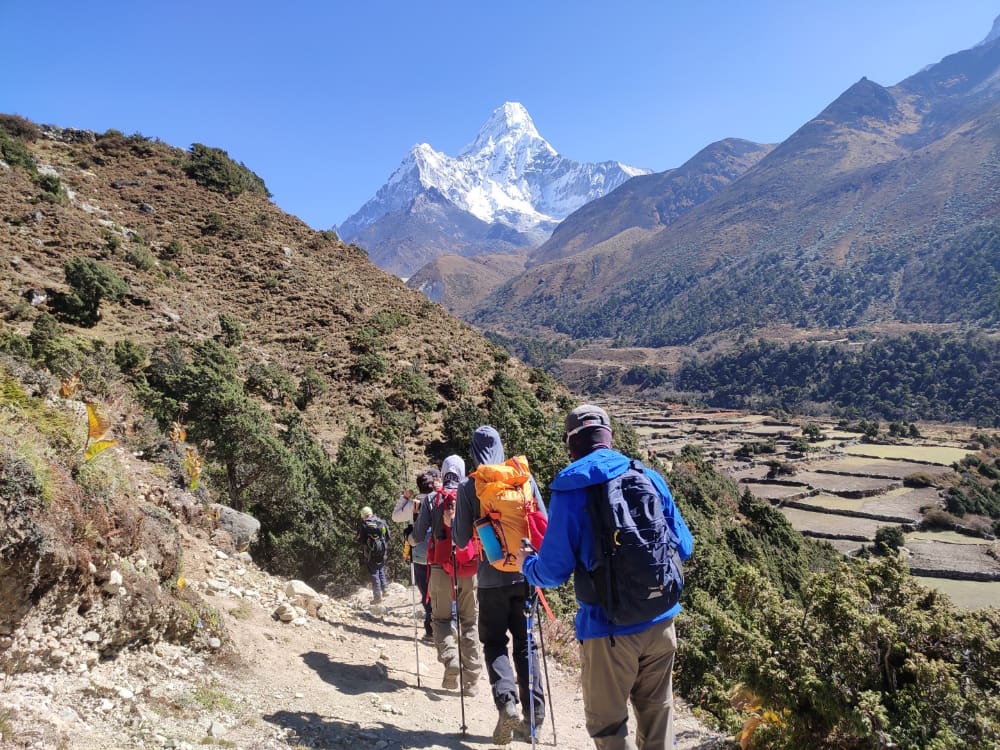Everest Base camp trek is once in a life time journey that promises breathtaking views and an opportunity to connect with nature like never before.
The journey to Everest Base Camp is a dream come true for adventure enthusiasts, thrill seekers, and nature lovers.
The Everest region is a sanctuary of natural beauty that demands our respect.
In the pursuit climbing towering peaks and witnessing breathtaking scenes, it is very important to remember that our footsteps can have a lasting impact on the fragile ecosystem.
As travelers we should be aware of our responsibility to ensure a path towards sustainable travel and make sure the pristine paradise remains as it is.
With its delicate ecosystem and unique biodiversity, every step we take leaves a mark.
If the impact of tourism is not managed properly, it can result in horrible outcomes. The trails can erode, waste can accumulate, and the cultural practices can be exploited. The impact isn’t just environmental; it also affects the local communities and their way of life.
It is essential to understand that our presence affects more than just the scenery-it shapes lives.
Sustainable trekking isn’t just a choice; it is a responsibility that echoes through every step and decision we make.
Let’s learn how to make our journey to Everest Base Camp sustainable, a step towards responsible adventure ensuring that the beauty of the Everest remains untouched for the generations to come.
1. Choosing Responsible Trekking Agencies
The first step in ensuring a sustainable Everest Base Camp journey is selecting a trekking and adventure agency that prioritizes environmental and social responsibility.
Look for agencies that adhere to Leave no Trace principles, employs local guides and porters, and support community development projects.
Choosing the right agency plays a vital role in reducing the negative impact of tourism on the region.
2. Packing Mindfully
Packing for a journey to Everest Base Camp is a task that requires thoughtfulness.
You should opt for an eco-friendly gear and clothing made from sustainable materials. Use multi-purpose clothing and gear to lessen the number of items you need to bring, because less is more.
Pack clothing that can be layered to accommodate different weather conditions, rather than bringing excessive clothing. Consider quick-drying and moisture-wicking fabrics to reduce the need for frequent washing.
Ditch single use plastics; pack reusable water bottles and water purification materials that minimizes plastic waste.
Additionally, pack energy-efficient portable charges to reduce the demand for disposable batteries.
3. Respect Local Culture and Communities
It is important to respect local customs and traditions.
The Sherpa culture is an integral part of the Everest Region.
While on your journey to Everest Base Camp, engage with the local community by learning a few basic phrases in their language, purchasing locally-made handicrafts, and supporting small businesses.
Research the local customs and dress modestly and respectfully. This shows consideration for the local culture and helps build positive relationships between you and the local community.
By forming positive relationships with the local people, you contribute to the sustainable development of the area and also gain deeper appreciation for the land you are exploring.
4. Leaving No Trace: A Trekker’s Mantra
One of the golden rules of sustainable trekking is to Leave No Trace.
As you make your way up to Everest Base Camp, it is important to minimize your impact on the environment.
Avoid picking plants or disturbing wildlife, stay on designated trails, and properly dispose of waste in designated bins.
Carry a small bag to collect any trash you encounter along the way and encourage others to do the same- it’s a small gesture with a big impact.
Bring your own reusable bags for shopping and refuse plastic bags when offered.
Imagine leaving behind no footprints, only memories.
5. Opt for Teahouse Accommodation
The Everest region offers a network of teahouses that provide cozy shelter and warm meals for trekkers.
Opting for teahouse accommodation not only supports the local economy around the Everest region but also reduces the need for building additional infrastructure that could harm the environment.
Be mindful of your energy and water usage while staying at these teahouses. Turnoff lights, heaters, and chargers when not in use, and limit the use of electronic devices to conserve electricity.
6. Greening your Trek: Carbon Offset Initiatives
Greening your trek refers to adopting environment friendly practices to minimize your ecological footprint and contribute to the preservation of the fragile Himalayan ecosystem
While travelling to remote locations like Everest Base Camp, it inevitably involves carbon emissions.
Theres a way to offset your footprint.
Many organizations offer carbon offset programs that channel funds into projects like reforestation and clean renewable energy initiatives.
It’s a small investment that has a big impact on the health of the planet.
7. Educate and Inspire
Your journey to Everest Base Camp is more than an adventure; its an opportunity to be a storyteller for the environment.
Document your journey, whether through writing, photography, or social media, use your platform to raise awareness about the importance of sustainable travel.
Sharing your experiences, highlighting the beauty of the region, and emphasizing the need to protect it for the future generations will have the power to inspire others to adopt eco-friendly travel practices which could save the pristine landscapes form degradation.
Trekking to Everest Base Camp is a privilege that comes with responsibilities to the environment, local communities, and the generations to follow.
Embarking on a Sustainable journey is not only a remarkable adventure but also a chance to be part of a positive change. Learning about the environmental challenges faced by the region and the efforts being made for conservation will help you make informed decisions and appreciate the natural beauty of the area even more.
By choosing responsible trekking agencies, packing mindfully, respecting local culture, and leaving no trace, we can ensure that our journey leaves behind a legacy of preservation rather than degradation.
The Himalayas have attracted adventurers for centuries; let’s answer that call with a commitment to sustainable exploration that leaves the mountains unspoiled for generations to come.
Like this post? Then you might also like Ladakh in Winter.






